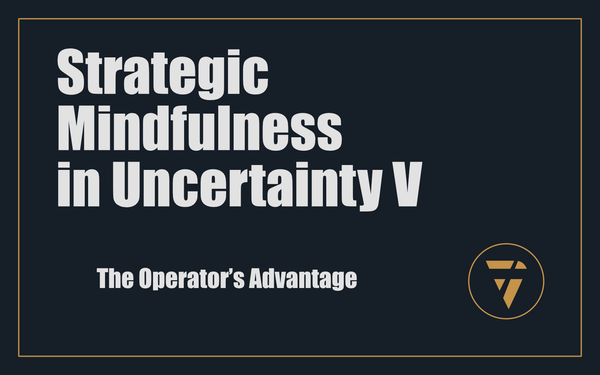Above or Below

Never Between
They’re shouting in the meeting.
You’re silent.
They’re spinning offers, edits, outcomes.
You see none of them matter.
They’re fighting over what the deck should say.
You know it’s the wrong room, wrong question, wrong fight.
This isn’t arrogance.
It’s altitude.
You’re not disengaged.
You’re above the chaos — or below it.
But never inside.
This is the hidden dimension of operational stillness: Position.
Not posture. Not tone.
Position.
Because in every moment of intensity, there are only three possible positions to occupy:
- Above — Strategic altitude.
You see the whole. You read the field. You compress the signal into a decision. Your nervous system is expansive, slow, sensing. - Below — Tactical anchor.
You hold the floor. You prevent drift. You absorb and convert chaos into direction. You breathe deeper than the room. - Between — The maelstrom.
You’re reacting. Interpreting signal as threat. Trying to fix what’s not yours. This is where founders die. Right in the middle.
Founders lose power not from failure, but from friction.
They sit in the noise and think it’s the work.
They reply too fast.
They defend too hard.
They diagnose too late.
They think their job is to be in every fight, instead of choosing when to hover and when to descend.
That’s the mistake: they collapse their system to match the room.
But stillness isn’t silence.
It’s structure.
—
What You’re Missing
Stillness isn’t peace.
It’s power.
And power requires nervous system hierarchy.
Let’s name it:
- Sympathetic Surge: That’s you in “between.” Caught. Collapsed. Reacting.
- Dorsal Dive: That’s the freeze. The shutdown. Not present. Not safe.
- Parasympathetic Command: That’s the zone. Calm, regulated, sensing. That’s above or below — depending on where the leverage is.
Most founders operate without tracking their state.
They confuse being busy with being important.
They mistake emotional charge for strategic clarity.
So they act — but not from compression.
They speak — but not from direction.
Here’s the rule:
If your breath is shallow, your decisions are too.
—
Deployment: Install the Above/Below Diagnostic
Step 1: Name the Room.
Before a meeting, ask:
- Am I being pulled into “between”?
- Is this a place I must hover over — or descend into?
Step 2: Regulate Before React.
- 4-7-8 Breath Protocol.
- Silence for 15 seconds before you speak.
- One sentence per insight.
Step 3: Signal the Position.
Use language like:
- “Let’s hold altitude.”
- “We’re anchoring now.”
- “This isn’t ours to solve from the middle.”
Step 4: Exit the Maelstrom.
If you're entangled — leave.
Either rise or root. But never spin.
—
For Your Ops Stack
- Nervous System Visibility as KPI. Weekly logs. Post-call pulse ratings.
- Position Tracker. Install “Above/Below/Between” as a field in every major project update or decision report.
- Meeting Structure Filters. Begin every call with “Where do we need to be — above or below?”
Stillness is not absence.
It’s altitude or anchor.
It’s your job to never get caught in between.
This is what I’m working on. Tell me what you think, I enjoy the conversation! Subscribe and follow the work in real time.
Thanks!
B

The middle is where founders drown.
Operate above — with altitude.
Anchor below — with calm.
But never get caught in between.
Stillness is position. Choose it.
PS -






